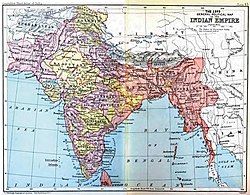Company Raj
| Company rule in India | ||||||||||||||||||
| Joint-stock colony established by the East India Company and regulated by the British Parliament. | ||||||||||||||||||
|
||||||||||||||||||
|
||||||||||||||||||
|
Motto Auspicio Regis et Senatus Angliae "By command of the King and Parliament of England" |
||||||||||||||||||
| Capital | Calcutta (1757–1858) | |||||||||||||||||
| Languages | English, and others | |||||||||||||||||
| Government | ||||||||||||||||||
| Governor-General | ||||||||||||||||||
| • | 1774–75 | Warren Hastings (first) | ||||||||||||||||
| • | 1857–58 | Charles Canning (last) | ||||||||||||||||
| History | ||||||||||||||||||
| • | Battle of Plassey | 23 June 1757 | ||||||||||||||||
| • | Treaty of Allahabad | 16 August 1765 | ||||||||||||||||
| • | Treaty of Seringapatam | 18 March 1792 | ||||||||||||||||
| • | Treaty of Bassein | 31 December 1802 | ||||||||||||||||
| • | Treaty of Yandabo | 24 February 1826 | ||||||||||||||||
| • | Treaty of Lahore | 9 March 1846 | ||||||||||||||||
| • | Government of India Act | 2 August 1858 | ||||||||||||||||
| Area | ||||||||||||||||||
| • | 1858 | 1,942,481 km² (749,996 sq mi) | ||||||||||||||||
| Currency | Rupee | |||||||||||||||||
|
||||||||||||||||||
| Today part of |
|
|||||||||||||||||

Imperial entities of India
|
|
| Dutch India | 1605–1825 |
|---|---|
| Danish India | 1620–1869 |
| French India | 1769–1954 |
|
|
|
| Casa da Índia | 1434–1833 |
| Portuguese East India Company | 1628–1633 |
|
|
|
| East India Company | 1612–1757 |
| Company rule in India | 1757–1858 |
| British Raj | 1858–1947 |
| British rule in Burma | 1824–1948 |
| Princely states | 1721–1949 |
| Partition of India |
1947
|
|
|
|
Company rule in India (sometimes, Company Raj, "raj," lit. "rule" in Hindi) refers to the rule or dominion of the British East India Company over parts of the Indian subcontinent. This is variously taken to have commenced in 1757, after the Battle of Plassey, when the Nawab of Bengal Sirajuddaulah surrendered his dominions to the Company, in 1765, when the Company was granted the diwani, or the right to collect revenue, in Bengal and Bihar, or in 1773, when the Company established a capital in Calcutta, appointed its first Governor-General, Warren Hastings, and became directly involved in governance. The Company's rule lasted until 1858, when, after the Indian rebellion of 1857, it was abolished. With the Government of India Act 1858, the British government assumed the task of directly administering India in the new British Raj.
The English East India Company ("the Company") was founded in 1600, as The Company of Merchants of London Trading into the East Indies. It gained a foothold in India with the establishment of a factory in Masulipatnam on the Eastern coast of India in 1611 and the grant of the rights to establish a factory in Surat in 1612 by the Mughal Emperor Jahangir. In 1640, after receiving similar permission from the Vijayanagara ruler farther south, a second factory was established in Madras on the southeastern coast. Bombay island, not far from Surat, a former Portuguese outpost gifted to England as dowry in the marriage of Catherine of Braganza to Charles II, was leased by the Company in 1668. Two decades later, the Company established a presence on the eastern coast as well; far up that coast, in the Ganges river delta, a factory was set up in Calcutta. Since, during this time other companies—established by the Portuguese, Dutch, French, and Danish—were similarly expanding in the region, the English Company's unremarkable beginnings on coastal India offered no clues to what would become a lengthy presence on the Indian subcontinent.
...
Wikipedia


